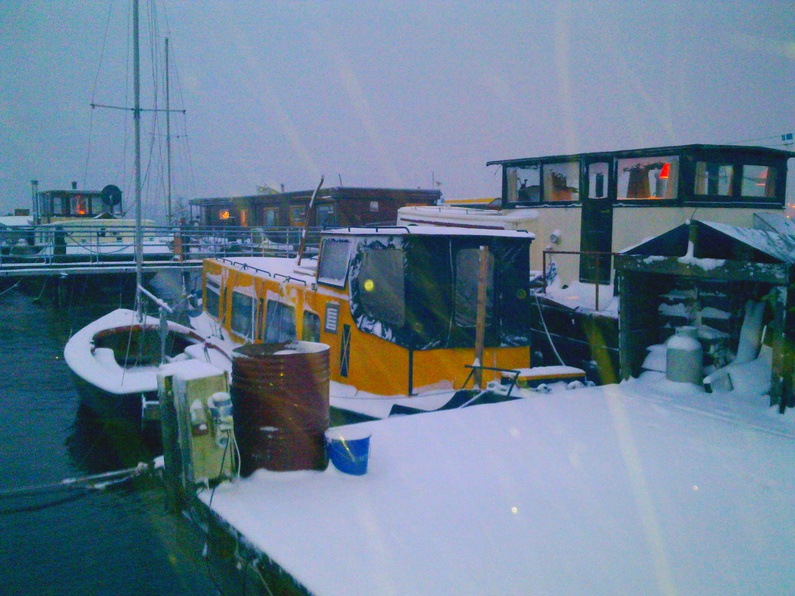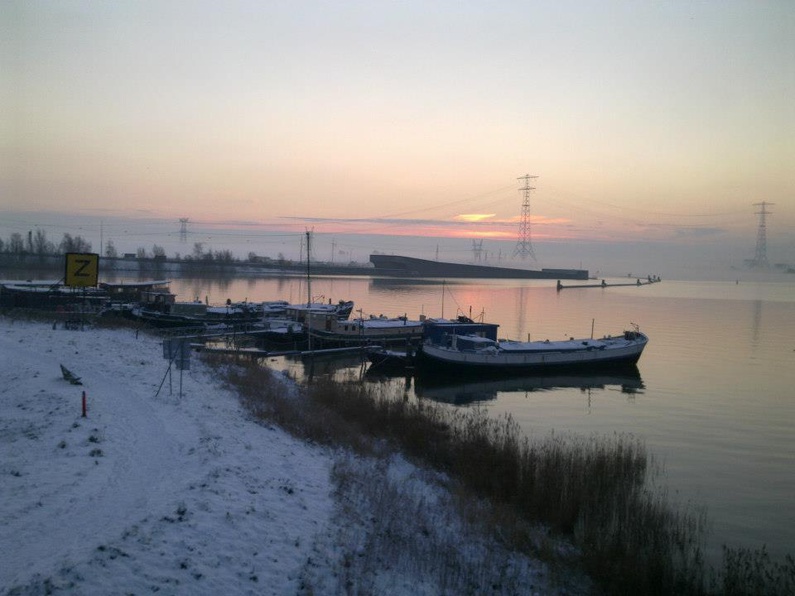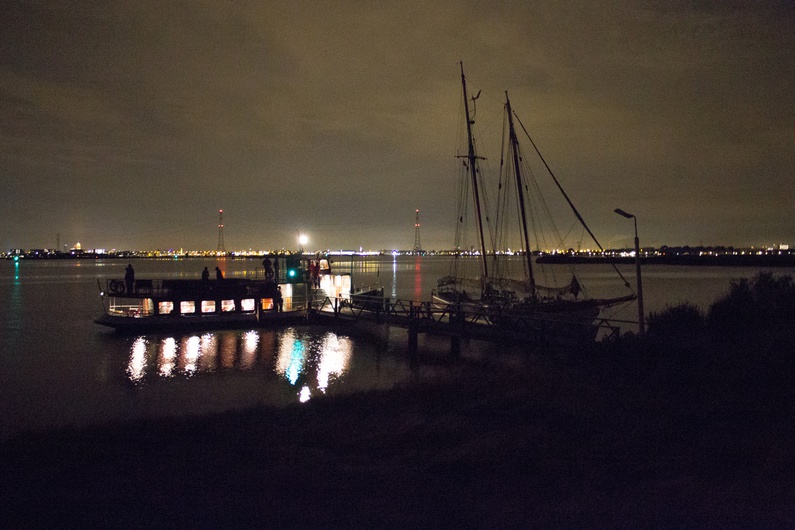
Pandora and I: My experience as an intern in Amsterdam
Published on
This is the story of a Canadian intern juggling the challenges of an internship in Amsterdam with the daily trials and tribulations of living on a boat on the canals of the Dutch capital.
The boat’s name was Pandora, which should tell you most of what you need to know.
She was a squat little boat, about the length of a U-Haul and painted a gaudy yellow and blue, and it would be a stretch to say she was attractive. What she did have was what people politely call “character”: a tiny, wood-panelled cabin, lined with starfish-printed curtains in white-and-blue. She was also blessed with a loyal spider colony, and a pilot light that only worked half the time. No working pilot light, no hot water. Frozen pipes? No water at all.
I moved aboard when I was 23, in the middle of an unusually blustery winter, about as unlikely a candidate for boat-living as one is likely to find. Besides being young, foreign, and notoriously unhandy, I had spent all my years previous devotedly landlocked. I had refused canoe trips at summer camp, spent cruises violently seasick, and failed swimming lessons out of sheer spite.
None of that had changed but, frankly, I was pressed for options.
False glamour and Search Engine Optimisation
I had moved to Amsterdam that fall to take an internship at a design publishing company, where I was as unlikely a choice for web editor as I was for living aboard Pandora.
When I arrived, I was only weeks removed from a summer stint at a big Toronto newspaper, where, as the bottom notch in an endless intern totem pole, I was quickly versed in that holy trinity of metropolitan crime: shootings, stabbings and freak accidents. My days, but more often nights, were spent in front of police scanners and flashing television screens, and the more exciting and gruesome my shifts became, the less equipped I was to relate to daylight hours and ordinary jobs.
I was also mildly terrified: I was a sheltered kid who had never faced life’s harder landings, and now I was tasked with recording the worst days of other people’s lives. Life suddenly looked different to me. I had no tragedies of my own, but my frequency had changed. For the first time, I was tuned into life’s bigger dramas.
None of this, of course, prepared me for the often glossy twilight zone of art and design. Clad in cowboy boots and a windbreaker, I was transplanted into what can sometimes look like a party, especially in Amsterdam, where fashion and design companies occupy the glittering office towers in the south and socialise under the swinging chandeliers of the canal streets of the inner city. My new room mates, a clutch of English underwear designers, were another introduction to this world, and so on my Facebook posts, I was sparkling, experiencing the benefits of both free underwear and pink champagne.
Of course, the daily reality was different. I spent that wet, gloomy fall in a tiny room in the west Amsterdam apartment I shared with the girls, surrounded by families with small children and the sounds of church bells tolling through our moulting walls. The room was papered over with tchotchkes and postcards: Amsterdam street scenes, pictures of Audrey Hepburn at Breakfast at Tiffany’s, novelty straws affixed with tiny paper pineapples, so that it resembled the room of a teenage daughter, one who had grown up and left the souvenirs of her childhood behind.
The room suited my mood at the time. I was an unlikely editor, an unlikely tenant, and it felt right to be occupying fragments of other people’s lives.
 I saw the pictures of Pandora on a housing website and then, in person, during a miserable Christmas gale.
I saw the pictures of Pandora on a housing website and then, in person, during a miserable Christmas gale.
She was docked on the sheep-dotted fringe of Amsterdam, a rural vision of Holland outfitted with windmills and neighbours who took out their garbage in clogs. On arriving, my future boat-lords ushered me onto their own vessel, a cosy affair with porthole windows and a fireplace. I sat on their couch while Yvette made tea and Floris set up the Christmas tree, tying it at both ends to keep it from pitching in the waves.
I would move aboard in January.
By then, if my arrival in the city felt as if it had been pulled from a rom-com montage, it had devolved into something of a tragi-comedy (there wasn’t much romance.) I missed the unglamorous scanner shifts and resented that the stress levels were higher when writing art-fair briefs than they were when covering gun crime.
On the design world, I was less persuaded than ever. It wasn’t design itself that I disliked, but the showings, the brochures, the slideshows of things, things, things, — things that never had a price tag in plain sight — and the alternate world they hawked: not a faith in the basic and the beautiful, but in the layers that could be put between you and the imperfect, a way to exist away from the problems and the tragedies and the little issues, the ugliness, that plagued other people.
Of course, I had come to Amsterdam in pursuit of this kind of life, a perfectionist looking for the kinds of things I figured I was supposed to want. I had attached myself to a greasy pole of false glamour and Search Engine Optimization, and was surprised to find there was no fulfillment or greater meaning in sight.
Still, I was obsessed with a judgment I told myself on the way to work each morning. You have to like this, I would repeat, over and over. People would kill to have this life.
A Life Aquatic
The trials of living on the boat included, in the following order: intermittently working water; keys dropped onto ice and retrieved with stick and coat hook (and then, later, dropped irretrievably into the thawed lake); snow on counters, on floors, ice in the sink, in the toilet, in the shower; a suitcase melted into the heater, spider colonies, spider bites, and, of course, endless mold. Every ordeal exhausted visitors, and made me love Pandora all the more.
 Daily routines required elaborate, mishap-filled rituals. The boat’s small heater, the only thing separating me from hypothermia, needed to be refilled with kerosene constantly. The process required four hands, a funnel, and the aid of a large axe, wielded on the swaying, icy deck. Invariably, this was done in the dark. In Amsterdam, in January, it is always dark.
Daily routines required elaborate, mishap-filled rituals. The boat’s small heater, the only thing separating me from hypothermia, needed to be refilled with kerosene constantly. The process required four hands, a funnel, and the aid of a large axe, wielded on the swaying, icy deck. Invariably, this was done in the dark. In Amsterdam, in January, it is always dark.
Taking a shower, if the pipes weren’t frozen, meant suctioning water out through a faulty pump. Even if the pump worked, this meant standing in at least an inch of stubborn, sloshing ice, under a trickle of water so limp you could come out of the shower practically as dry as you went in, only colder.
Cooking a meal depended on the fickle efforts of a single working burner, so I boiled pasta in the kettle instead.
Most of all, it was damp, and cold. I developed the kind of health problem that one gets from effectively living outdoors: constant colds, a busted, bloody eardrum, and what my doctor would later diagnose as a permanently heightened risk of gangrene.
Even reaching the boat was an ordeal: the tram ride from central Amsterdam was easy enough, but it was only the prelude to a half-hour walk over an exposed bridge and along a muddy road, bordered by a wind-whipped, foggy dijk.
The walk seemed endless, but it had its own, wintry appeal: captains waved as their passing barges plowed through the ice below, and seagulls rested on the locks at night, squawking in the oily lights of the boats tethered along the dijk. And so, over time, the walk became a daily meditation, a forced anathema to any sort of glamour, any sort of extraneous design.
 That spring, six months of steady rain started to lighten, just in bursts. In those days, as the lake began to thaw, I developed small habits, little pilgrimages — a provoking of my solitary feelings.
That spring, six months of steady rain started to lighten, just in bursts. In those days, as the lake began to thaw, I developed small habits, little pilgrimages — a provoking of my solitary feelings.
Pandora, for her part, celebrated spring by threatening to sink.
I awoke one Saturday to find a slow seeping from my bathroom, but now I was accustomed to every mishap, so failed to panic and went to go get groceries instead.
When I came back, the water was spreading even further across my floor. Floris came by to peel back her little blue deck, revealing the half-submerged pipes and spouts of her engine. He knew bits and pieces of her story: built around World War II in Holland, she had been built to carry coal. She had once belonged to an artist, who toured the country with her before disappearing to Brazil and leaving her behind, like an unwanted cat.
Her name was Pandora, he said, and the thawing of the lake’s ice had proven too much for the old girl’s pipes.
It was a blessing that she was so small. On a bigger boat, by the time you saw the water, it was too late.
I didn’t mind; I felt reassured that she, at least, could show she was sinking.
Life lessons
My day job involved the curating, if not creation, of fantasy: a love of objects that slipped beyond materialism into all-consuming reverence. And in my own way, I began to slip into fantasy, too.
Socially, I had retreated back to childhood, and my friend group consisted mostly of the local sheep, my own monologues, and stories, conducted in bulk during the fog of my morning walks. I imagined my life as an odyssey aboard Pandora, sketching journeys through the magical underside of the city: following in the path of swans and slipping under the tiny bridges over the canals, grazing the feet of tourists who were kissing after staying up all night.
In the evenings and on Sundays, I walked for hours: tracing my progress through the city in street names, a solo explorer tucked into the backs of cafes. I had spent the autumn as a specter, willing myself to disappear into another sort of life, and now I stepped back into solitude and embraced it as a conspicuous choice.
I had been a closet perfectionist who went to Amsterdam for the glitz, but through a half-year of near solitude I had flailed, repulsed by the smooth surfaces I had always been striving to create.
Instead, I had spent those months making small decisions, to stop adding things onto my life, things that didn’t mean anything to me, pricey chairs and lamps and easy ideas, and to start facing the simpler things.
In April, I finished my internship, gratefully giving up the world of high-end design. I spent the last weeks on Pandora, now a warm haven for her spiders, bobbing on the lake while the waves from passing barges lengthened the ropes that tied her to the dock, tempting her to sail away.
 When I left the Netherlands, I didn’t forget Pandora.
When I left the Netherlands, I didn’t forget Pandora.
Landlocked once more, I continue to think of myself as one part of a clanking, wind-whipped duo, a flawed but charming girl-boat team, slipping through the canals of Amsterdam when the streets are deserted and the sky is already bright.
It’s my myth, my fable. And since every fable has a moral, what did Pandora teach me?
She taught me that being good takes something more than good intentions, and something more than guilt. It takes work and discipline, and kindness and an empathy – for yourself as much as for others. I thought I was sinking, and adult life – the smallest, most mundane details – were harder and more complicated than I ever thought they would be. But it takes time and intention to be a person who can think for themselves, a person who puts in more than they take out. That it’s a job you start early and know will take the length of your life.
So, when I think about what Pandora taught me, I think she taught me the most important thing I could have learned at 23. She taught me how to accept imperfection, and still float.



